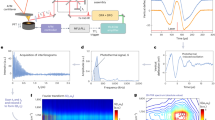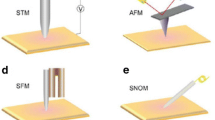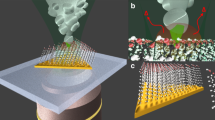Abstract
The near-field optical response generated at the apex of a scanning probe in tip-enhanced Raman spectroscopy (TERS) enhances and confines the interaction of light and matter to a few nanometers, thus breaking the diffraction limit of light while preserving the wealth of chemical and structural information. With the way paved to deploy Raman spectroscopy to surface nanostructures, we now investigate the most favorable experimental conditions and possible limitations for tip-enhanced hyper-Raman spectroscopy (TEHRS). In this two-photon-one phonon process, detected around the second harmonic of the excitation wavelength, selection rules different from those of the conventional Raman effect apply, thus holding promise for an almost comprehensive vibrational signature of the sample. TEHRS signal intensity critically depends on the second harmonic generation (SHG) efficiency. The aim of this work is to outline the experimental conditions that are best suited to obtain TEHRS signals in the challenging context of an extremely low scattering cross section. Using a silver tip and non-centrosymmetric PbTiO3 film on platinum substrate as a sample system in our simulations, we show a strong dependence of the intensity of SHG on the polarization of the incident light, the tip radius, the presence of a non-centrosymmetric sample, and the excitation power. We further discuss the effect of tip-sample distance for early-stage (proof of concept) TEHRS investigations and found 40% of total power dissipation for 1 nm distance.






Similar content being viewed by others
References
Chen C, Hayazawa N, Kawata S (2014) A 1.7 nm resolution chemical analysis of carbon nanotubes by tip-enhanced Raman imaging in the ambient. Nat Commun 5:3312. https://doi.org/10.1038/ncomms4312
Stöckle RM, Suh YD, Deckert V, Zenobi R (2000) Nanoscale chemical analysis by tip-enhanced Raman spectroscopy. Chem Phys Lett 318:131–136. https://doi.org/10.1016/S0009-2614(99)01451-7
Cançado LG, Hartschuh A, Novotny L (2009) Tip-enhanced Raman spectroscopy of carbon nanotubes. J Raman Spectrosc 40:1420–1426. https://doi.org/10.1002/jrs.2448
Kumar N, Mignuzzi S, Su W, Roy D (2015) Tip-enhanced Raman spectroscopy: principles and applications. EPJ Tech Instrum 2:9. https://doi.org/10.1140/epjti/s40485-015-0019-5
Dab C, Kolhatkar G, Plathier J, Thomas R, Ruediger A (2018) Dependence of apertureless scanning near-field spectroscopy on nanoscale refractive index changes. Plasmonics 13:99–106. https://doi.org/10.1007/s11468-016-0488-7
Awada C, Plathier J, Dab C, Charra F, Douillard L, Ruediger A (2016) High resolution scanning near field mapping of enhancement on microscopy. Phys Chem Chem Phys 18:9405–9411. https://doi.org/10.1039/C5CP08015K
Frontiera RR, Gruenke NL, Van Duyne RP (2012) Fano-like resonances arising from long-lived molecule-plasmon interactions in colloidal nanoantennas. Nano Lett 12:5989–5994. https://doi.org/10.1021/nl303488m
Frontiera RR, Henry AI, Gruenke NL, Van Duyne RP (2011) Surface-enhanced femtosecond stimulated Raman spectroscopy. Phys Chem Lett 242:1199–1203. https://doi.org/10.1002/cphc.201600104
Kneipp J, Kneipp H, Kneipp K (2006) Two-photon vibrational spectroscopy for biosciences based on surface-enhanced hyper-Raman scattering. Proc Natl Acad Sci U S A 103:17149–17153. https://doi.org/10.1073/pnas.0608262103
Gruenke NL, Cardinal MF, McAnally MO et al (2016) Ultrafast and nonlinear surface-enhanced Raman spectroscopy. R Soc Chem 45:2263–2290. https://doi.org/10.1039/C5CS00763A
Klingsporn JM, Sonntag MD, Seideman T, Van Duyne RP (2014) Tip-enhanced Raman spectroscopy with picosecond pulses. J Phys Chem Lett 5:106–110. https://doi.org/10.1021/jz4024404
Takeuchi O, Aoyama M, Oshima R, Okada Y, Oigawa H, Sano N, Shigekawa H, Morita R, Yamashita M (2004) Probing subpicosecond dynamics using pulsed laser combined scanning tunneling microscopy. Appl Phys Lett 85:3268–3270. https://doi.org/10.1063/1.1804238
Berweger S, Atkin JM, Olmon RL, Raschke MB (2012) Light on the tip of a needle: plasmonic nanofocusing for spectroscopy on the nanoscale. J Phys Chem Lett 3:945–952. https://doi.org/10.1021/jz2016268
Xu XG, Raschke MB (2013) Near-field infrared vibrational dynamics and tip-enhanced decoherence. Nano Lett 13:1588–1595. https://doi.org/10.1021/nl304804p
Berweger S, Atkin JM, Xu XG, Olmon RL, Raschke MB (2011) Femtosecond nanofocusing with full optical waveform control. Nano Lett 11:4309–4313. https://doi.org/10.1021/nl2023299
Denev SA, Lummen TTA, Barnes E et al (2011) Probing ferroelectrics using optical second harmonic generation. J Am Ceram Soc 94:2699–2727. https://doi.org/10.1111/j.1551-2916.2011.04740.x
García de Abajo F, Howie A (1998) Relativistic electron energy loss and electron-induced photon emission in inhomogeneous dielectrics. Phys Rev Lett 80:5180–5183. https://doi.org/10.1103/PhysRevLett.80.5180
Davis M, Budimir M, Damjanovic D, Setter N (2007) Rotator and extender ferroelectrics: importance of the shear coefficient to the piezoelectric properties of domain-engineered crystals and ceramics. J Appl Phys 101:054112. https://doi.org/10.1063/1.2653925
Johnson PB, Christy RW (1972) Optical constants of the noble metals. Phys Rev B 6:4370–4379. https://doi.org/10.1103/PhysRevB.6.4370
Singh S (1972) Nonlinear optical properties of ferroelectric lead titanate. Appl Phys Lett 20:135–137. https://doi.org/10.1063/1.1654078
Rakic AD, Djurisic AB, Elazar JM et al (1998) Optical properties of metallic films for vertical-cavity optoelectronic devices. Appl Opt 37:5271–5283
Zhang M, Wang R, Zhu Z, Wang J, Tian Q (2013) Experimental research on the spectral response of tips for tip-enhanced Raman spectroscopy. J Opt 15:055006. https://doi.org/10.1088/2040-8978/15/5/055006
Pozzi EA, Sonntag MD, Jiang N, Klingsporn JM, Hersam MC, van Duyne RP (2013) Tip-enhanced Raman imaging: an emergent tool for probing biology at the nanoscale. ACS Nano 7:885–888. https://doi.org/10.1021/nn400560t
Barnes WL, Dereux A, Ebbesen TW (2003) Surface plasmon subwavelength optics. Nature 424:824–830. https://doi.org/10.1038/nature01937
Torres-Torres C, Reyes-Esqueda JA, Cheang-Wong JC, Crespo-Sosa A, Rodríguez-Fernández L, Oliver A (2008) Optical third-order nonlinearity by nanosecond and picosecond pulses in Cu nanoparticles in ion-implanted silica. J Appl Phys 104:014306. https://doi.org/10.1063/1.2952040
Metzger B, Hentschel M, Nesterov M, Schumacher T, Lippitz M, Giessen H (2016) Nonlinear optics of complex plasmonic structures: linear and third-order optical response of orthogonally coupled metallic nanoantennas. Appl Phys B Lasers Opt 122:77. https://doi.org/10.1007/s00340-016-6348-5
Baida H, Billaud P, Marhaba S, Christofilos D, Cottancin E, Crut A, Lermé J, Maioli P, Pellarin M, Broyer M, del Fatti N, Vallée F, Sánchez-Iglesias A, Pastoriza-Santos I, Liz-Marzán LM (2009) Quantitative determination of the size dependence of surface plasmon resonance damping in single Ag at SiO2 nanoparticles. Nano Lett 9:3463–3469. https://doi.org/10.1021/nl901672b
Muskens OL, Billaud P, Broyer M, del Fatti N, Vallée F (2008) Optical extinction spectrum of a single metal nanoparticle: quantitative characterization of a particle and of its local environment. Phys Rev B 78:1–9. https://doi.org/10.1103/PhysRevB.78.205410
Burns G, Scott BA (1970) Raman studies of underdamped soft modes in PbTiO3. Phys Rev Lett 25:167–170. https://doi.org/10.1103/PhysRevLett.25.167
Anderson A, Deryckx KS, Xu XG, Steinmeyer G̈, Raschke MB (2010) Few-femtosecond plasmon dephasing of a single metallic nanostructure from optical response function reconstruction by interferometric frequency resolved optical gating. Nano Lett 10:2519–2524. https://doi.org/10.1021/nl101090s
Shahbazyan V, Tigran V, Stockman MI (2013) Plasmonics: theory and applications. Challenges. https://doi.org/10.1007/978-94-007-7805-4
Finazzi M, Biagioni P, Celebrano M, Duò L (2007) Selection rules for second-harmonic generation in nanoparticles. Phys Rev B 76:125414. https://doi.org/10.1103/PhysRevB.76.125414
Hao F, Sonnefraud Y, Van Dorpe P et al (2008) Symmetry breaking in plasmonic nanocavities: subradiant LSPR sensing and a tunable Fano resonance. Nano Lett 8:3983–3988. https://doi.org/10.1021/nl802509r
Radziuk D, Moehwald H (2014) Highly effective hot spots for SERS signatures of live fibroblasts. Nanoscale 6:6115–6126. https://doi.org/10.1039/c4nr00594e
Xu XG, Rang M, Craig IM, Raschke MB (2012) Pushing the sample-size limit of infrared vibrational nanospectroscopy: from monolayer toward single molecule sensitivity. J Phys Chem Lett 3:1836–1841. https://doi.org/10.1021/jz300463d
Berweger S, Atkin JM, Olmon RL, Raschke MB (2010) Adiabatic tip-plasmon focusing for nano-Raman spectroscopy. J Phys Chem Lett 1:3427–3432. https://doi.org/10.1021/jz101289z
Govorov AO, Zhang W, Skeini T, Richardson H, Lee J, Kotov NA (2006) Gold nanoparticle ensembles as heaters and actuators: melting and collective plasmon resonances. Nanoscale Res Lett 1:84–90. https://doi.org/10.1007/s11671-006-9015-7
Govorov AO, Richardson HH (2007) Generating heat with metal nanoparticles. Nanotoday 2:30–38. https://doi.org/10.1016/S1748-0132(07)70017-8
Lee KS, M a E-S (2006) Gold and silver nanoparticles in sensing and imaging: sensitivity of plasmon response to size, shape, and metal composition. J Phys Chem B 110:19220–19225. https://doi.org/10.1021/jp062536y
Lee J, Govorov AO, Dulka J, N a K (2004) Bioconjugates of CdTe nanowires and Au nanoparticles: plasmon-exciton interactions, luminescence enhancement, and collective effects. Nano Lett 4:2323–2330. https://doi.org/10.1021/nl048669h
Berini P, De Leon I (2011) Surface plasmon–polariton amplifiers and lasers. Nat Photonics 6:16–24. https://doi.org/10.1038/nphoton.2011.285
Acknowledgments
C.D. gratefully acknowledges the partial financial support through a Tunisia-INRS scholarship and technical support from CMC Microsystems for COMSOL Multiphysics. A.R. is grateful for the NSERC discovery grant.
Author information
Authors and Affiliations
Corresponding author
Rights and permissions
About this article
Cite this article
Dab, C., Awada, C. & Ruediger, A. Tip-Enhanced Second Harmonic Generation: an Approach for Hyper-Raman Spectroscopy. Plasmonics 14, 653–661 (2019). https://doi.org/10.1007/s11468-018-0843-y
Received:
Accepted:
Published:
Issue Date:
DOI: https://doi.org/10.1007/s11468-018-0843-y




